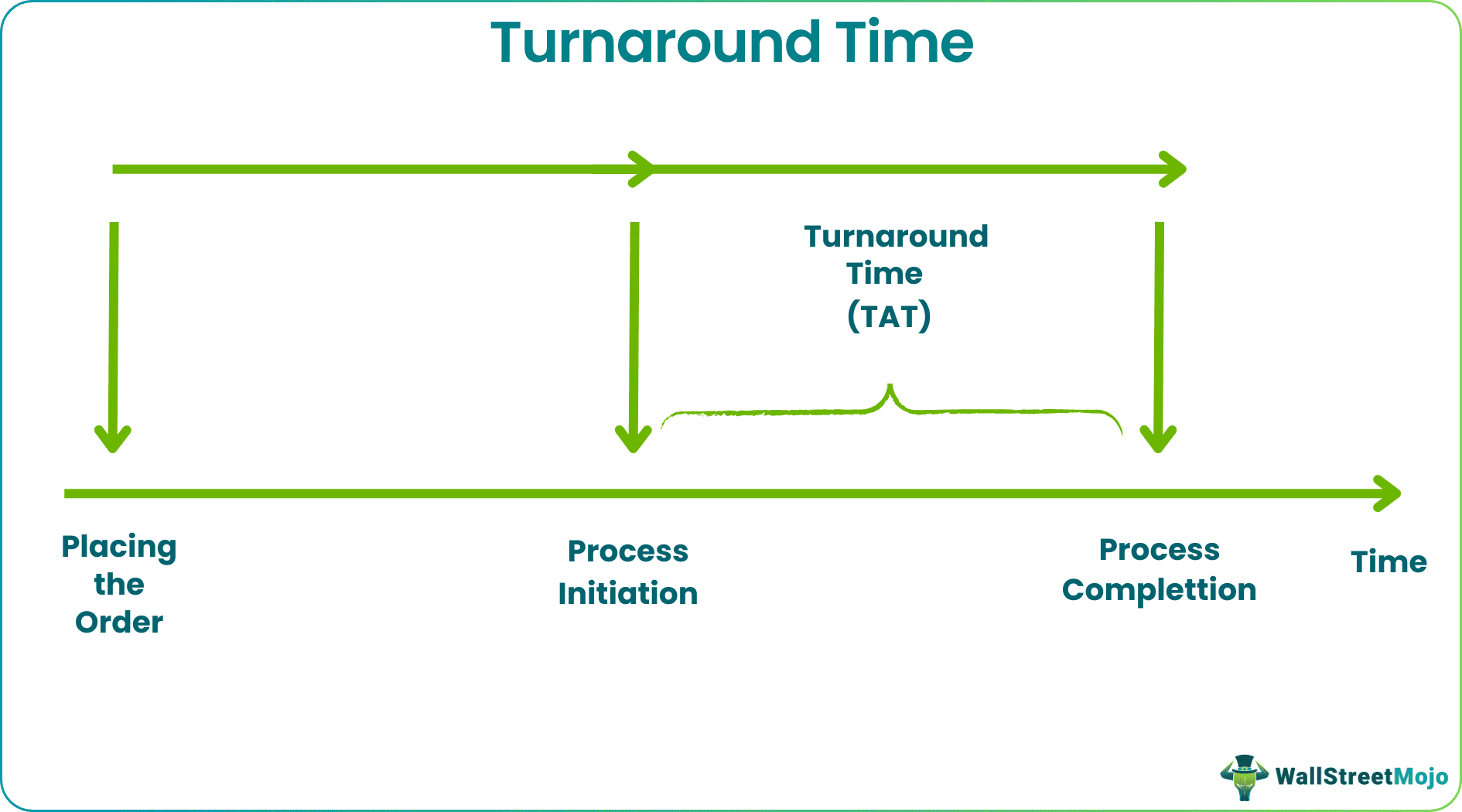Table Of Contents
Turnaround Time (TAT) Meaning
Turnaround time is the time required to complete a process. It is the duration between request submission and process completion. This metric is commonly used in task scheduling and Operating System algorithms. It is abbreviated as TAT.

TAT is also calculated as the difference between completion time and arrival time. Businesses use TAT to assess how fast they can serve their customers. A quick TAT reflects efficient maintenance, upgrades, tasks, algorithms, and productivity. Therefore, every business tries to reduce the TAT.
Key Takeaways
- Turnaround time (TAT) refers to the time taken by a process from initiation to completion.
- TAT is predominantly used in shipping, computing, logistics, scheduling, and operating systems.
- Firms aim for more work done in minimum TAT. Customers also want the same thing; no one wants to wait long. Consequently, TAT directly correlates with customer satisfaction, market retention, and brand perception.
- To improve TAT, businesses cut unnecessary steps and reduce communication. Simultaneously, these measures also end up cutting costs.
Turnaround Time Explained
Turnaround time (TAT) is the time taken to complete a process. It is measured as the duration between an order request and the task completion (execution). It sapplies to any process, task, operation, or activity but is usually used in manufacturing, computing, or logistics.
Many businesses use TAT to assess how fast they can serve their customers. Thus, firms aim for more work done in minimum TAT—customers also want the same thing. Thus, TAT directly correlates with customer satisfaction, market retention, and brand perception.
To reduce TAT, companies strategize and implement various ideas and tools. In computing, the firm attempts new algorithms.
The term is confused with other similar metrics—lead time, waiting time, etc. Each industry has different terminology. For example, in manufacturing, TAT refers to the time taken for maintenance, upgrade, and fixation. On the other hand, in the context of computing, TAT refers to the duration between submission and the output (result). TAT refers to the duration between order submission and order fulfillment in logistics.
Formula
The turnaround time formula is as follows:
Turnaround Time = Completion Time - Arrival Time
Alternatively, it is also calculated as follows:
TAT = Burst Time + Waiting Time
Here, ‘Burst Time’ denotes the time required to request a process.
Example
Let us assume that arrival and completion data (in hours) for a process is as follows:
- P1 (arrival time = 2, completion time = 3)
- P2 (arrival time = 4, completion time = 6)
- P3 (arrival time = 6, completion time = 9)
- P4 (arrival time = 9, completion time = 11)
Here, P represents the process.
Now, according to the formula,
- TAT = Completion Time - Arrival Time
We apply the formula and deduce values for each process.
- P1 = 1
- P2 = 2
- P3 = 3
- P4 = 2
Therefore, we get the following collaborative TAT:
- Collaborative TAT = P1 + P2 + P3 + P4 (1 + 2 + 3 + 2)
- Collaborative TAT = 8
Now the average TAT is computed as follows:
- Average TAT = (P1 + P2 + P3 + P4) /4
- Average TAT = 8/4 = 2
Thus, the turnaround time is 8 hours, whereas the average turnaround time is 2 hours.
Importance
The importance of turnaround time is as follows:
- In business, time is often equated with money; the longer the process, the larger the monetary expenditure. In that context, a shorter TAT directly results in increased profits.
- Services with less TAT help create goodwill and trust among consumers. Customers dislike waiting for long periods.
- A business that encounters a longer TAT struggles to survive in a competitive market.
- To improve TAT, businesses cut unnecessary steps and reduce communication. Simultaneously, these measures also end up cutting costs.
Turnaround Time And Waiting Time
Now, let us compare turnaround time and waiting time.
- Turnaround time (TAT) is the duration between a process leaving the queue and getting completed. On the other hand, waiting time refers to the total time. Waiting time also includes the time spent in the queue.
- TAT affects the speed of the output device or channel. In contrast, waiting time does not affect the output speed.
- For the same process, an algorithm can produce multiple TATs. In contrast, algorithms cannot alter the waiting time.
Turnaround Time vs Lead Time vs Throughput
- Turnaround time (TAT) defines a job's total amount of time. On the other hand, the lead time is the gap between the order placement and delivery. In contrast, throughput is a data processing unit.
- The turnaround and the lead are measured in time units. On the contrary, throughput is the rate at which a company can offer services or manufacture products.
- A company will always seek to improve its turnaround and lead time by reducing it. On the other hand, businesses try to increase their throughput.
- When a business reduces TAT or lead times, customers are happier (they have to wait less). In comparison, when a business increases throughput, it generates more revenue.
